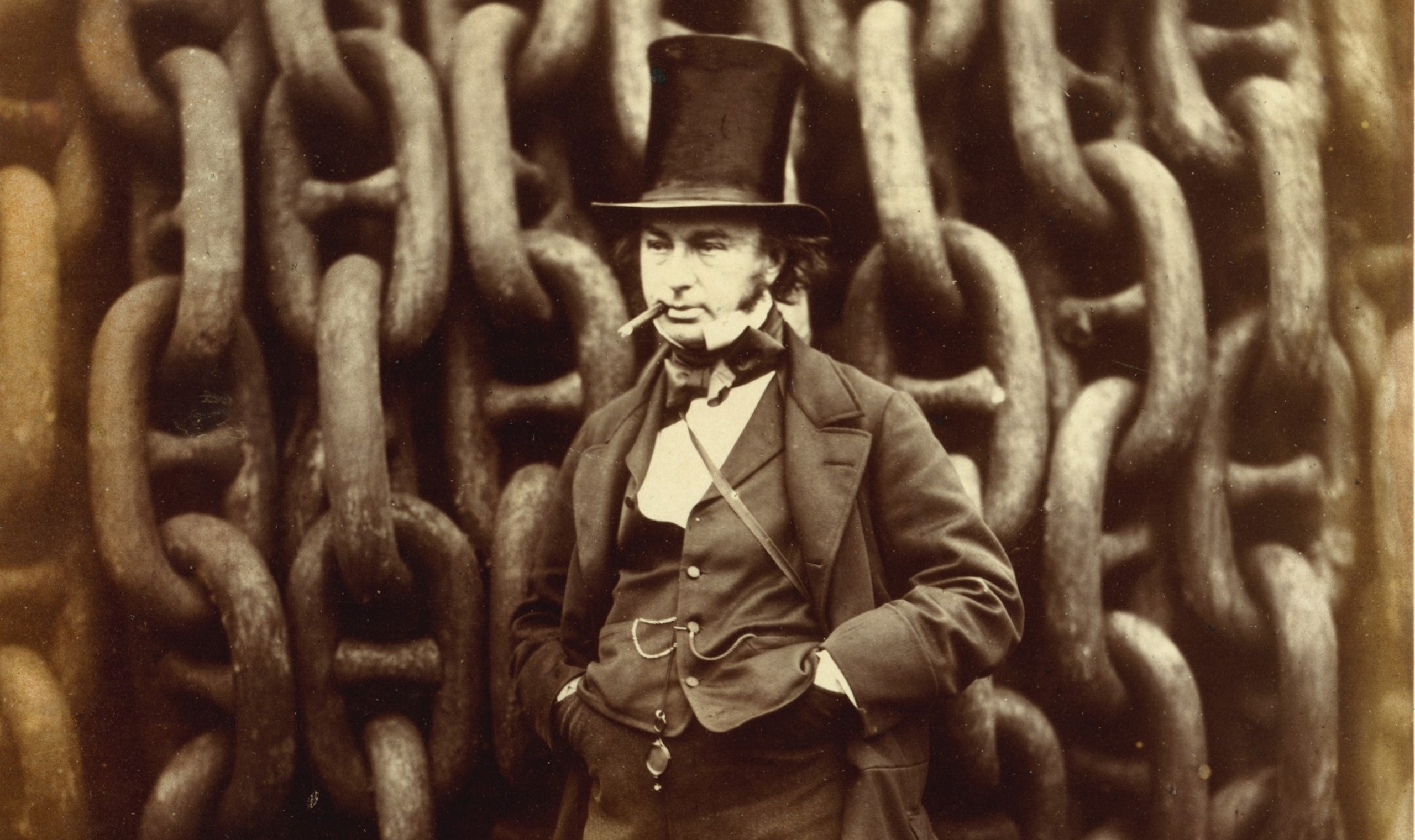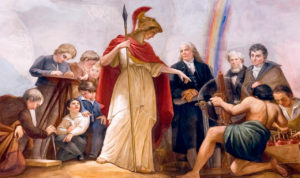I am opposed to the laying down of rules or conditions to be observed in the construction of bridges lest the progress of improvement tomorrow might be embarrassed or shackled by recording or registering as law the prejudices or errors of today. —Isambard Kingdom Brunel
Victorian Britain was the birthplace of the Industrial Revolution. The invention of the steam engine at the end of the 18th century brought about a wave of changes to people’s lives. Long-distance travel became available to the masses, new manufacturing processes made products cheaper than ever before, and innovative technologies made possible new construction processes, expanding the kinds of structures people could build.
The world-changing advances developed in 19th-century Britain were made possible by heroic men working tirelessly to achieve goals many considered impossible. Richard Trevithick invented the steam locomotive, Robert Stephenson turned railways into a safe form of passenger transport, and Thomas Telford pioneered the use of cast iron in bridges and buildings. One of the most inspiring figures to emerge from Victorian Britain, however, was Isambard Kingdom Brunel.
The son of engineer Marc Brunel, the young Isambard made his mark in the field of engineering at an early age. He and his father took over a project to build the first-ever pedestrian tunnel beneath the River Thames in 1825 when the younger Brunel was just twenty-one years old. The project had been abandoned twenty years earlier after a disastrous flood, and many considered the project impossible. Despite the Brunels’ deployment of an innovative new “tunnel shield,” river water still broke through and flooded the tunnel repeatedly, one local clergyman describing these floods as a “just judgment upon the presumptuous aspirations of mortal men.”1 Although undeterred by the pessimism of others, Isambard had no choice but to leave the project after being seriously injured during one of these floods. Fortunately, others would go on to complete Brunel’s work. Almost two hundred years later, the tunnel remains in use. It later was adapted for railway services and now carries hundreds of trains every day on the busy East London Line, something few could have foreseen in Brunel’s time.
Brunel used his bedrest productively. During the time recovering from his injuries, he planned a host of what he hoped would be future projects, including a large new house for himself, a striking new suspension bridge over the Thames, and even a fleet of ships to lead a siege on Algiers. Unfortunately, in the years following the accident he was beset with challenges and failures. For instance, he spent many years developing a new power source called the “gaz engine,” which turned out to be fundamentally flawed.
In 1829, he entered a contest to design a new bridge to span the wide and steep Avon Gorge at Clifton in Bristol. The committee had hired Thomas Telford, one of the most famous designers of the day, to judge the competition. Telford rejected all of the designs, putting forth his own. The committee rejected this design as too expensive and ran a second competition. This time Brunel won, and construction on his bridge started in 1831. Unfortunately, riots over national politics got in the way, and work was paused with only the towers on either side of the gorge completed. These stood without the bridge for three decades and became known as “The Follies.” Although construction eventually resumed after Brunel’s death, he never got to see it completed. Nonetheless, the bridge stands today as a striking monument to his skill and fortitude.

Brunel's Clifton Suspension Bridge standing proud today (July 2020)
The troubles with the Clifton Bridge, however, turned out to be a blessing in disguise for Brunel, causing him to take work in Bristol. The newly formed Great Western Railway (GWR) soon approached him to become the surveyor for a new line they were planning from London to Bristol. Brunel, according to his diaries, worked twenty hours a day for more than two months to personally survey the entire 110-mile route.
GWR was so impressed by Brunel’s skill, persuasiveness, and determination that, in 1834, the company sent the twenty-eight-year-old engineer to defend the railway’s plans against challenges in Parliament. These were instigated primarily by competitors along the route, including the Kennet & Avon Canal and two other railways. Brunel’s powerful manner and clear demonstration of engineering prowess won the day, and, in 1835, GWR gained parliamentary approval to build the line.
The design of the GWR line demonstrated Brunel’s genius, his dogged determination, and his powerful penchant for unconventional thinking. Years earlier, while riding a train on the Liverpool and Manchester Railway, Brunel had written of his dream to create fast, stable train travel without the bumps and shakes he’d experienced on that journey. The GWR, as built, was like a line from the future. It didn’t have the tight curves and fluctuating gradients of contemporary railways. These were replaced with long straights, smooth curves, and tremendous feats of engineering that maintained level grades throughout. The line cut across the landscape on an almost direct route between the two cities. This has enabled today’s railway companies to operate electric trains at up to 125 mph over the entire route. By contrast, other lines are limited to lower speeds or have to be rebuilt to accommodate today’s faster trains.
At Maidenhead, where the GWR had to cross the Thames, Brunel proposed a large twin-arch brick bridge with a single pillar on an island in the river. His colleagues in the engineering profession told him that such wide brick arches could never stand, but he pressed on all the same. Today, the Maidenhead bridge still stands, handling far more traffic than ever envisaged at the time and at far higher speeds—and it remains the widest brick arch bridge ever constructed.
Around this time, Brunel’s genius even saved his own life. After doctors were unable to remove a coin he had swallowed that got stuck in his throat, Brunel, over the course of eleven days, designed and built his own centrifugal pivot system, which hurled him to and fro until the coin came loose.2
In addition to the bridge at Maidenhead, Brunel designed similarly impressive marvels of engineering at other points along the GWR route. The 1.83-mile-long Box Tunnel near Bath took two and a half years to construct and was described as the “finest work in England,” and the mile-long Sonning Cutting (a deep trench where the railway runs in the open below ground level) near Twyford reaches sixty feet deep. Brunel’s various bridges and other structures along the route remain impressive, even by today’s standards. But the fact that one man designed them without the aid of modern technology, using only pen, paper, and basic tools, makes their grandeur all the more inspiring.
The most unusual thing about the GWR line, however, was Brunel’s decision to use wider track than was standard elsewhere in England (and much of the world). Instead of spacing the rails 4 feet 8.5 inches apart, as had all other major railways, Brunel opted for a unique 7 feet 0.25 inches “broad gauge.” This, he argued, would make trains safer, smoother, and faster.
Unfortunately, the system was far more expensive to build than “standard gauge,” and the use of two different gauges created break-of-gauge situations where the GWR met other railways, and trains could not run through. To solve this problem, Brunel proposed “containerizing” goods so that they could be moved easily from one train to another—a concept that ultimately would be put into use more than a century later, in the 1960s. However, Parliament ultimately mandated that the GWR convert to standard gauge to remove the logistical problem. We can only imagine what incredible trains might be running on the route today if broad gauge had been retained.
Thanks in large part to Brunel’s contributions, the GWR grew to be the largest railway company in Britain. He oversaw the construction of new lines across the west of England, creating a railway empire reaching from the south coast to Liverpool and from London to the western tip of Cornwall at Penzance. Not content with this, Brunel decided to extend GWR’s reach even further west, designing a novel steamship that could take much larger loads across the ocean than ever before. This new ship, christened the Great Western, was based on a simple principle that no one before him had discovered: “that whereas the carrying capacity of a hull increases as the cube of its dimensions, its resistance, that is the power needed to drive it through the water, only increases as the square of those dimensions.”3 This breakthrough enabled Brunel to build far larger steamships than were possible before, which he used to create a transatlantic shipping system that effectively extended the GWR from Bristol to New York. Brunel went on to build two more pioneering steamships, the Great Britain and the Great Eastern. Although the latter met disaster, the Great Britain survives to this day, restored and on display in Bristol harbor.
Although his triumphs would outshine them, more failures and disasters beset his later years. Compounding the loss of the Great Eastern and the failure of the broad gauge, Brunel suffered defeat in his plans to build a unique new pressure-propelled “atmospheric railway” along the South Devon coast, an idea so far ahead of its time that today’s innovators once again are proposing a similar system.
Brunel’s fast-paced, traumatic life eventually caught up with him, and he died in 1859 at the age of fifty-three. In his short years, however, he had a phenomenal impact on the world. In spite of numerous naysayers; countless setbacks; and titanic challenges, both physically and financially; Brunel built marvels of engineering that still stand today. His innovations catalyzed the transatlantic trade that drove the latter part of the Industrial Revolution on both sides of the Atlantic.
In 1923, sixty-four years after Brunel’s death, the government decided to meddle with the nation’s railways. It reorganized Britain’s railways, which at the time consisted of several dozen separate systems, into four large companies. Three of the companies created were new, but the Great Western Railway was so large and self-sufficient that the planners retained it. Thus, the GWR outlived all of its contemporaries, lasting until British railways were nationalized in 1948.
That is not where the GWR story ends, however. The newly formed state-owned British Railways (BR) was broken into four regions along the lines of the old companies. Those in control of BR’s “Western Region” managed to retain many of the GWR’s distinctive ways of operating. For instance, all the way into the diesel era, the Western Region continued to use its own unique locomotives unlike those used across the rest of the country. Eventually, in the 1990s, history came full circle, and the railways were returned to private operation. In 2015, First Great Western decided to rename the company Great Western Railway in recognition of the company that built its route.

The new Great Western Railway: A GWR Intercity Express Train stops at Didcot Parkway on a London to Bristol service in July 2020.
Brunel’s life and achievements show just what’s possible when an individual combines drive and determination with a deep commitment to learning and hard work. In 2002, BBC viewers voted him the second greatest Briton of all time, second only to Winston Churchill—beating out such luminaries as William Shakespeare, Charles Darwin, and Isaac Newton.4
Today, it is once again possible to board a “Great Western Railway” train from Brunel’s magnificent glass-roofed station at London Paddington. Traveling the route Brunel himself surveyed, the modern GWR will carry you to his equally stunning station at Bristol Temple Meads in just one hour and eighteen minutes. Across Britain, Isambard Kingdom Brunel’s innovations stand as triumphant monuments to his genius—and likely will for centuries to come.
Click To Tweet
You might also like
Endnotes
1. Andrew Dickinson White, A History of the Warfare of Science with Theology in Christendom: Volume 2 (Piscataway, NJ: Transaction Publishers, 2012), 286.
2. Richard Tames, Lifelines 1: Isambard Kingdom Brunel (Aylesbury: Shire Publications, 1972), 18.
3. Tames, Lifelines 1: Isambard Kingdom Brunel, 29.
4. BBC News, Churchill Voted Greatest Briton (November 24, 2002), http://news.bbc.co.uk/1/hi/entertainment/2509465.stm (accessed July 31, 2020).
















